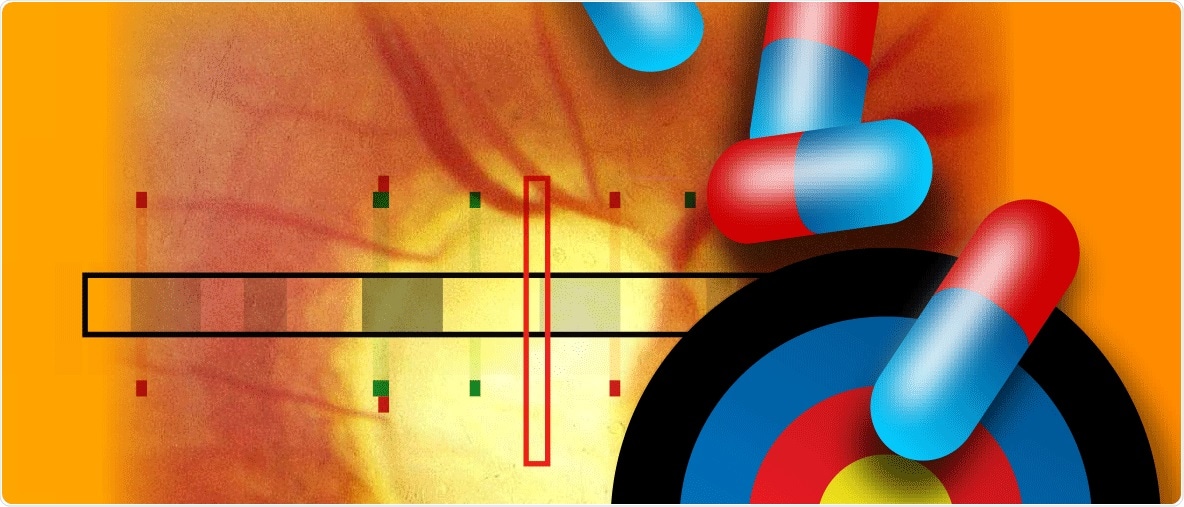An international team of researchers, headed by scientists from Stanford University and the University of Helsinki, has discovered unique changes in a gene, known as ANGPTL7, that reduce intraocular pressure and considerably decrease the risk of glaucoma. The study results offer new and important therapeutic possibilities.

Changes in a gene called ANGPTL7 lower intraocular pressure and reduce the risk of glaucoma. Image Credit: Manuel Rivas, adapted from image by Lauren Solomon, Broad Communications.
Glaucoma is an eye disorder that affects around 80 million people. Currently, it is the second leading cause of blindness in the world. This disease causes progressive damage to the optic nerve head, leading to a corresponding loss of visual field and, in severe cases, even leads to blindness.
The pressure inside the eye, or the intraocular pressure, is the only adjustable risk factor for glaucoma.
Glaucoma has a distinct genetic component, and researchers have identified tens of common genetic variants that affect intraocular pressure, increase glaucoma risk, or both. But so far, the clinical impact of these outcomes has been negligible.
In the research, published in the PLOS Genetics journal, scientists looked for genetic variants that are less common and may reduce the intraocular pressure and protect from glaucoma. They targeted those that have a clear impact on the function of the matching protein product.
Variants like these have specifically high therapeutic potential because they would emphasize a certain gene and a genetic variation that protects from the disease.
The study results are based on two major European cohorts with the availability of large-scale genome and health information data. On the whole, over 514,000 individuals from the Finnish FinnGen and the UK Biobank studies were analyzed.
Both study cohorts include scores of individuals diagnosed with glaucoma. Also, more than 120,000 UK Biobank participants had taken part in the intraocular pressure measurement tests.
The two study cohorts offered convincing, complementary, and independent proof of the ANGPTL7 gene involved in glaucoma. The UK Biobank participants carried a number of rare genetic variations that were demonstrated to decrease the intraocular pressure, whereas the FinnGen study offered solid proof of another variant that was specific to the Finnish population and which considerably reduced the risk of glaucoma.
The variant we identified is more than 50 times more common in the Finnish population than elsewhere in the world. In fact, more than 8% of Finns carry it and have a substantially reduced risk of glaucoma. This again demonstrates how the population history of the Finns makes it much easier to identify clinically important genetic variants.”
Mark Daly, Study Co-Lead and Professor, Institute for Molecular Medicine Finland, University of Helsinki
Daly continued, “With clinic-based recruitment focused on several areas including ophthalmology, and with more than 30 % of the participants being above age 70, FinnGen is particularly well-powered for aging-associated endpoints.”
We often think of the body as a machine whereby taking a single bolt out of that machine and something could go wrong. In this study that hypothetical bolt made the ‘machine’ work even better by protecting human individuals from glaucoma. Our results highlight the benefits of multi-cohort analysis for the discovery of rare protein-altering variants in common diseases, and ANGPTL7 provides the best therapeutic hypothesis out there for glaucoma.”
Manuel Rivas, Study Co-Lead and Assistant Professor of Biomedical Data Science, School of Medicine, Stanford University
Most significantly, cohorts, like the UK Biobank and FinnGen, enable the scientists to evaluate whether the identified protective variants also raise the risk of some other medical condition.
Using the comprehensive health information in the two population cohorts, we assessed the potential impacts of rare genetic variants in ANGPTL7 on a spectrum of human disorders. We did not find any severe medical consequences that would be of obvious concern in developing a therapeutic to mimic the effect of these alleles.”
Yosuke Tanigawa, Study Author and Doctoral Student, School of Medicine, Stanford University
Better knowledge of the pathological and genetic mechanisms behind the intraocular pressure can pave the way for treating or preventing glaucoma. In this example, the genetic study supports the prevention or reduction of the amount of ANGPTL7 as a possible safe and effective treatment method for glaucoma.
“Our results position angiopoietin-like 7 as an appealing and safe target for glaucoma therapies. If a drug can be developed that mimics the protective effect of these mutations, intraocular pressure in at-risk individuals could be lowered,” Daly concluded.
Source:
Journal reference:
Tanigawa, Y., et al. (2020) Rare protein-altering variants in ANGPTL7 lower intraocular pressure and protect against glaucoma. PLOS Biology. doi.org/10.1371/journal.pgen.1008682